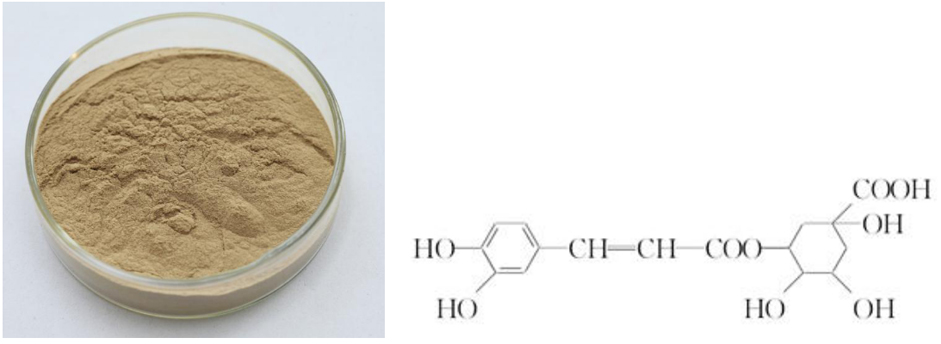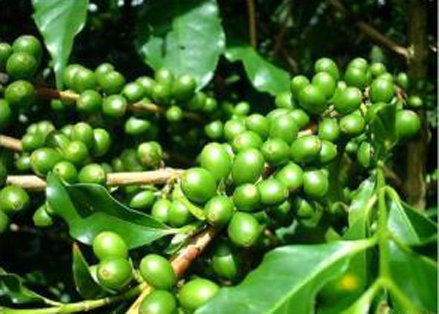China Wholesale for Green Coffee Bean Extract Factory for The Swiss
China Wholesale for Green Coffee Bean Extract Factory for The Swiss Detail:
[Latin Name] Coffea arabica L.
[Plant Source] from China
[Specifications] chlorogenic acid 10%-70%
[Appearance] Yellow brown fine powder
Plant Part Used:Bean
[Particle size] 80 Mesh
[Loss on drying] ≤5.0%
[Heavy Metal] ≤10PPM
[Storage] Store in cool & dry area, keep away from the direct light and heat.
[Shelf life] 24 Months
[Package] Packed in paper-drums and two plastic-bags inside.
[Net weight] 25kgs/drum
[Brief Introduction]
Green Coffee Bean Extract is sourced from Europe and is standardized to more than 99% Chlorogenic Acid. Chlorogenic Acid is the compound present in coffee. Which has been long known as for its beneficial properties. This active ingredient akes Green Coffee Bean an excellent agent to absorb free oxygen radicals; as well as helping to avert hydroxyl radicals, both which contribute to degradation of cells in the body.Green Coffee Beans have strong polyphenols which act to help reduce free oxygen radicals in the body, but it is standardized to more than 99% Cholorgenic Acid, a dietary polyphenol that helps to regulate metabolism.Test results showed Green Coffee Bean had more than double the rate of oxygen radical absorbance capability when compared to green tea and grape seed extracts
[Main Functions]
1.Chlorogenic acid, long known as an antioxidant with potential anti-cancer activity, also slows the release of glucose into bloodstream after a meal.
2.lower one’sblood sugar level, suppress the appetite, lower blood pressure, and reduce levels of visceral fat.
3.Useful in fighting the free radicals in our bodies that can damage our cells and contribute to conditions such as cardiovascular disease. Test results
showed Green Coffee Bean had more than double the rate of oxygen radical absorbance capability when compared to green tea and grape seed extracts.
4.Act as an effective painkiller especially for migraine medications;
5.Reduce the risk of diabetes.
Product detail pictures:

Related Product Guide:
continue to improve, to ensure product quality in line with market and customer standard requirements. Our company has a quality assurance system have been established for China Wholesale for Green Coffee Bean Extract Factory for The Swiss , The product will supply to all over the world, such as: Roman, Gambia, Madagascar, Our company now has many department, and there have more than 20 employees in our company. We set up sales shop, show room, and product warehouse. In the meantime, we registered our own brand. We've got tightened inspection for quality of product.
What is BIOPOLYMER? What does BIOPOLYMERmean? BIOPOLYMER meaning – BIOPOLYMER pronunciation – BIOPOLYMER definition – BIOPOLYMER explanation – How to pronounce BIOPOLYMER?
Source: Wikipedia.org article, adapted under https://creativecommons.org/licenses/by-sa/3.0/ license.
Biopolymers are polymers produced by living organisms; in other words, they are polymeric biomolecules. Since they are polymers, biopolymers contain monomeric units that are covalently bonded to form larger structures. There are three main classes of biopolymers, classified according to the monomeric units used and the structure of the biopolymer formed: polynucleotides (RNA and DNA), which are long polymers composed of 13 or more nucleotide monomers; polypeptides, which are short polymers of amino acids; and polysaccharides, which are often linear bonded polymeric carbohydrate structures.
Cellulose is the most common organic compound and biopolymer on Earth. About 33 percent of all plant matter is cellulose. The cellulose content of cotton is 90 percent, for wood it is 50 percent.
A major defining difference between biopolymers and synthetic polymers can be found in their structures. All polymers are made of repetitive units called monomers. Biopolymers often have a well-defined structure, though this is not a defining characteristic (example: lignocellulose): The exact chemical composition and the sequence in which these units are arranged is called the primary structure, in the case of proteins. Many biopolymers spontaneously fold into characteristic compact shapes (see also “protein folding” as well as secondary structure and tertiary structure), which determine their biological functions and depend in a complicated way on their primary structures. Structural biology is the study of the structural properties of the biopolymers. In contrast, most synthetic polymers have much simpler and more random (or stochastic) structures. This fact leads to a molecular mass distribution that is missing in biopolymers. In fact, as their synthesis is controlled by a template-directed process in most in vivo systems, all biopolymers of a type (say one specific protein) are all alike: they all contain the similar sequences and numbers of monomers and thus all have the same mass. This phenomenon is called monodispersity in contrast to the polydispersity encountered in synthetic polymers. As a result, biopolymers have a polydispersity index of 1.
The convention for a polypeptide is to list its constituent amino acid residues as they occur from the amino terminus to the carboxylic acid terminus. The amino acid residues are always joined by peptide bonds. Protein, though used colloquially to refer to any polypeptide, refers to larger or fully functional forms and can consist of several polypeptide chains as well as single chains. Proteins can also be modified to include non-peptide components, such as saccharide chains and lipids.
The convention for a nucleic acid sequence is to list the nucleotides as they occur from the 5′ end to the 3′ end of the polymer chain, where 5′ and 3′ refer to the numbering of carbons around the ribose ring which participate in forming the phosphate diester linkages of the chain. Such a sequence is called the primary structure of the biopolymer.
Sugar-based biopolymers are often difficult with regards to convention. Sugar polymers can be linear or branched and are typically joined with glycosidic bonds. The exact placement of the linkage can vary, and the orientation of the linking functional groups is also important, resulting in ?- and ß-glycosidic bonds with numbering definitive of the linking carbons’ location in the ring. In addition, many saccharide units can undergo various chemical modifications, such as amination, and can even form parts of other molecules, such as glycoproteins.
A funny story that actually happened to me.
The the help i asked you for: Just click here https://bit.ly/Nmm3Zt
The customer service reprersentative explained very detailed, service attitude is very good, reply is very timely and comprehensive, a happy communication! We hope to have a opportunity to cooperate.







